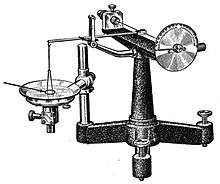Du Noüy ring method

A du Noüy ring tensiometer. The arrow on the left points to the ring itself.

Close up of the ring drawn out of the liquid.
The du Noüy ring method is one technique by which the surface tension of a liquid can be measured. The method involves slowly lifting a ring, often made of platinum, from the surface of a liquid. The force, , required to raise the ring from the liquid's surface is measured and related to the liquid's surface tension, :
where is the radius of the inner ring of the liquid film pulled and is the radius of the outer ring of the liquid film.[1]
This technique was proposed by the French physicist Pierre Lecomte du Noüy (1883–1947) in a paper published in 1925.[2]
See also
References
- ↑ Butt, Hans-Jürgen; Graf, Karlheinz; Kappl, Michael (2003). "Physics and Chemistry of Interfaces": 14–15.
- ↑ du Noüy, Pierre Lecomte (1925). "An Interfacial Tensiometer for Universal Use". The Journal of General Physiology. 7 (5): 625–633. doi:10.1085/jgp.7.5.625.
External links
- Papers of Pierre Lecomte du Noüy, 1883-1972
- Movie showing a du Noüy tensiometer
- Picture of a du Noüy tensiometer (National Institutes of Health)
| Wikimedia Commons has media related to Du Noüy ring method. |
This article is issued from Wikipedia - version of the 11/29/2016. The text is available under the Creative Commons Attribution/Share Alike but additional terms may apply for the media files.